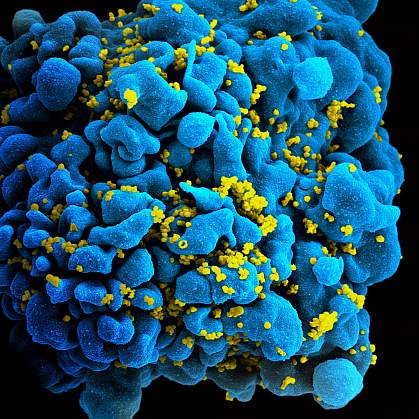You are here
October 25, 2016
Sustained SIV remission achieved in monkeys
At a Glance
- An experimental antibody therapy helped fully suppress an HIV-like infection in monkeys for nearly 2 years after the treatment ended.
- The findings suggest an alternative HIV therapy that might eliminate the need for lifelong drug regimens.

The HIV virus, which causes AIDS, and the similar monkey virus SIV usually cause permanent infections once established in the body. Antiretroviral therapy (ART) can suppress these viruses to very low levels in the blood. Yet the virus still lurks in the genetic material of infected immune cells, known as viral reservoirs. If ART is discontinued, virus levels rebound within weeks. Thus, treatment for HIV today involves taking ART every day for life. Although ART dramatically improves health overall and prolongs life, the regimen can be challenging and may have toxic side effects over time.
The gut is one of the first body areas damaged by HIV and SIV. During early infection, the viruses target immune cells in gastrointestinal tissues called CD4 cells. CD4 cells move into the gut using a surface protein called alpha-4/beta-7 integrin, which interacts with the protein MAdCAM-1 on the cells of the blood vessels that line gastrointestinal tissues.
A team led by Dr. Aftab A. Ansari at Emory University and Dr. Anthony S. Fauci, director of NIH’s National Institute of Allergy and Infectious Diseases (NIAID), investigated whether preventing CD4 cells from accessing gut tissues could avert the damage and its effects on the immune system. The researchers developed an antibody against alpha-4/beta-7 integrin to block it from interacting with MAdCAM-1. Their study appeared on October 14, 2016, in Science.
The scientists infected 18 rhesus macaques with SIV. Five weeks later, the animals began a 90-day course of daily ART. Nine weeks after infection, the animals started receiving an antibody infusion every 3 weeks. Eleven were given the investigational antibody; the other 7 received placebo antibody. Three of the 11 monkeys developed an immune response against the investigational antibody and were excluded from further study. All treatment ceased 32 weeks after infection for the 15 remaining animals.
By their third week on ART, all the monkeys fully suppressed SIV. Within 2 weeks after ART ceased, SIV rebounded to high levels in all 7 control animals. SIV returned temporarily but was then subdued in 6 of the 8 monkeys who received the investigational antibody. The virus never rebounded in the other 2. These 8 monkeys have continued to have undetectable levels of SIV in their blood and gut tissues for as long as 23 months.
How the antibody treatment is working remains unclear. Treated monkeys had replenished CD4 levels. They had other notable immune changes. For example, some treated animals developed antibodies against an important region of gp120, a protein that HIV and SIV need to grip and gain entry to CD4 cells.
“The experimental treatment regimen appears to have given the immune systems of the monkeys the necessary boost to put the virus into sustained remission,” Fauci says. “The precise mechanisms of this effect are unclear and will be actively pursued, since they could have important implications for the control of HIV infection in humans.”
The investigational antibody is similar to the human drug vedolizumab, which is approved by the U.S. Food and Drug Administration for treating ulcerative colitis and Crohn’s disease. A small, early-phase clinical trial to test the treatment regimen in HIV-infected people has begun at the NIH Clinical Research Center in Bethesda, Maryland.
Related Links
- HIV Vaccine Progress in Animal Studies
- HIV Immunotherapy Promising in First Human Study
- Benefits of Early Antiretroviral Therapy in HIV Infection
- Key HIV Protein Structure Revealed
- Vaccine Clears Away Monkey AIDS Virus
- The Structure and Dynamics of HIV Surface Spikes
- HIV/AIDS
- AIDS.gov
References: Sustained virologic control in SIV+ macaques after antiretroviral and α4β7 antibody therapy. Byrareddy SN, Arthos J, Cicala C, Villinger F, Ortiz KT, Little D, Sidell N, Kane MA, Yu J, Jones JW, Santangelo PJ, Zurla C, McKinnon LR, Arnold KB, Woody CE, Walter L, Roos C, Noll A, Van Ryk D, Jelicic K, Cimbro R, Gumber S, Reid MD, Adsay V, Amancha PK, Mayne AE, Parslow TG, Fauci AS, Ansari AA. Science. 2016 Oct 14;354(6309):197-202. PMID: 27738167.
Funding: NIH’s National Institute of Allergy and Infectious Diseases (NIAID), Eunice Kennedy Shriver National Institute of Child Health and Human Development (NICHD), and Office of Research Infrastructure Programs; U.S. Food and Drug Administration; German Primate Center; University of Maryland School of Pharmacy Mass Spectrometry Center; Center for the AIDS Program of Research in South Africa (CAPRISA); University of Michigan; and Johns Hopkins School of Medicine.
